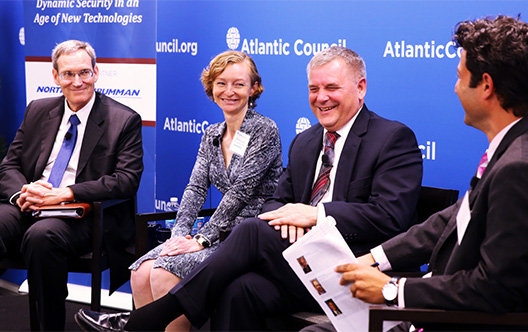 As the head of the the US Missile Defense Agency, Patrick O’Reilly saw a lot of advanced military technology. But of late, one of the most intriguing advancements he has seen has come from a few newly graduated engineers at a commercial wireless company. With a 3D printer, they have created new antenna shapes that make possible wholly new waveforms. The compactness of the shapes the printer can creates suits them very well for jamming packages on small drone aircraft. And the fundamental expendability of drones creates opportunities for new operational concepts in electronic warfare.
As the head of the the US Missile Defense Agency, Patrick O’Reilly saw a lot of advanced military technology. But of late, one of the most intriguing advancements he has seen has come from a few newly graduated engineers at a commercial wireless company. With a 3D printer, they have created new antenna shapes that make possible wholly new waveforms. The compactness of the shapes the printer can creates suits them very well for jamming packages on small drone aircraft. And the fundamental expendability of drones creates opportunities for new operational concepts in electronic warfare.
James Cartwright extolled this sort of responsiveness in industry, offering some observations from experience on tactical cycle time from the campaigns in Iraq and Afghanistan. Signals intelligence and security is a 40-day fight, he said, before the enemy adapts to new techniques and systems. IEDs are a 30-day fight, between insurgents’ electronic triggers, counterinsurgents’ countermeasures, and insurgents next efforts. And cyber is shaping up to be at most a 20-day fight, as new software techniques can be developed that rapidly.
Technology, however, is not the only input on the battlefield. Citing historical examples from the Second World War through the present, Rebecca Grant observed that the most disruptive threats to US military forces have come not solely from new weapons, but new operational concepts. (My own essay with Byron Callan argues just that.) But as Moisés Naím noted in an earlier panel discussion, and O’Reilly repeated, the disruptive threats of the century so far have been cyber-weapons, drone aircraft, and those IEDs—all technologies relatively accessible by actors of modest means. In some cases, mastering the operational employment of these technologies does not require deep financial resources and scale economies.
The Pentagon, of course, is facing its own financial constraints. Recounting the trade space between military capability and capacity, Cartwright expressed enthusiasm for two types of solutions to the latter problem. The first is technological solutions that radically expanding capacity by reducing logistic footprints. Precision weaponry and long range sensors, he argued, have allowed US ground forces to accomplish with brigades what formerly took field armies. Naval directed energy and rail guns may eventually supplant expensive missiles that only last until the relatively limited magazines run out. And with no analog for ammunition, offensive cyber weapons may be in a game-changing class of their own.
The second is what Cartwright called “cognitive mobility”—the export of expertise by telepresence. We already see this in applications from telemedicine to distance learning to remote piloting. In the last example, he noted the similarly capacity-expanding possibilities of not just removing the pilot from the cockpit, but from the training pipeline. Maintaining hand-eye proficiency in people ultimately consumes about 50 percent of the operating and maintenance costs of manned aircraft over their life cycles.
Financial constraints are not wholly bad, Cartwright argued, as they can forces innovative choices that comfortable budgets may not. This may be why he called for greater modularity in the development of new systems, and greater reliance on payloads over platforms. Grant echoed the sentiment in her call for greater field experimentation in robotics, to learn what that suite of technologies can really do today militarily. And all three panelists cited the IED and MRAP experience in Iraq as harbinger for future conflict, and a forgettable experience that must not be forgotten. The biggest issue in that campaign, Cartwright recalled, was not that US military failed to find technical solutions to the threat, but that it could not adapt conceptually and operationally for a fight it had not anticipated.
Senior Fellow James Hasik provides some summary thoughts on the panel discussion “Preparing the Military for Coming Challenges” at the Atlantic Council’s conference Disrupting Defense: Dynamic Security in an Age of New Technologies Kevin Baron, executive editor of Defense One, moderated the discussion amongst James E. Cartwright, Harold Brown Chair in Defense Policy Studies at the Center for Strategic and International Studies, Dr. Rebecca Grant, president of IRIS Independent Research, and Senior Fellow Patrick O’Reilly.

